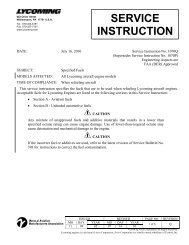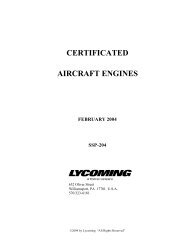Create successful ePaper yourself
Turn your PDF publications into a flip-book with our unique Google optimized e-Paper software.
called a “whistle slot.” The operator of any aircraft should know<br />
which method is used for preventing freezing of the breather<br />
tube, and should ensure that the configuration is maintained as<br />
specified by the airframe manufacturer.<br />
Because of its simplicity, the “whistle slot” is often used.<br />
Although the end of the tube may extend into the air stream, a<br />
notch or hole in the tube is located in a warm area near the engine<br />
where freezing is extremely unlikely. When a breather tube with<br />
whistle slot is changed, the new tube must be of the same design.<br />
Replacing a slotted tube with a non-slotted tube could result in an<br />
incident like the one described by the lady from Maine.<br />
The <strong>Flyer</strong> may have carried information on this subject in the<br />
past, but the reminder from someone who had an unfortunate<br />
incident prompted this story. Preventing possible freezing of the<br />
crankcase breather tube by use of a whistle slot or other means is<br />
an important little detail which all of our readers should be aware<br />
of. Many may benefit from the knowledge.<br />
If you are told that a cylinder head on your engine should be<br />
welded because of a crack, think long and hard about the step<br />
you are about to take. The argument is that it is less expensive to<br />
recondition a cylinder head than to buy a new one. This is true<br />
when the only consideration is getting your aircraft back in the<br />
air as cheaply as possible. For the long run, welding the aluminum<br />
parts of an aircraft engine to repair cracks may not be a permanent<br />
solution, and may cause you many headaches.<br />
The recommendation to replace rather than weld is based on<br />
years of experience and thousands of examinations in the<br />
<strong>Lycoming</strong> Metallurgical Laboratory. Based on this experience,<br />
the vast knowledge of the individuals who work in this Met Lab<br />
should not be ignored. The brief explanation that follows will<br />
attempt to relate some of this experience and to explain why<br />
welding is not generally recommended.<br />
Starting with two very basic but critical items in the welding<br />
process, we look at the material to be welded and the welder.<br />
The material is an aluminum alloy, and it takes more than just a<br />
very good welder to successfully weld aluminum. The experience<br />
in qualifying welders at the factory shows is that only the most<br />
outstanding can pass the annual FAA qualifying examination for<br />
Aircraft Certified Welder. Even a good welder may leave tungsten<br />
in the weld. This causes it to be unsatisfactory.<br />
Even an expert welder with complete knowledge of the aluminum<br />
alloy material cannot assure a satisfactory weld in a cracked<br />
engine part. There are many inherent pitfalls over which the<br />
welder has no control. Cylinder heads are made of aluminum<br />
alloy. Cracks sometimes occur inside the dome area. The metallurgists<br />
consider repair by welding to be absolutely foolish, and<br />
their experience provides them with good reasons. The surface<br />
area in the dome is affected by a thermochemical attack — to put<br />
L y c o m i n g F l y e r<br />
it simply, corrosion. This corrosion is a form of oxidation that will<br />
not fuse properly during welding. It is not practical to remove all<br />
of the corrosion, because this would entail remachining the entire<br />
interior surface which would change the designed compression<br />
ratio of the engine. Those who attempt to weld this area make<br />
an effort to clean the crack thoroughly. Unfortunately, this is of<br />
little help because the area adjacent to the cleaned-out crack will<br />
still be affected by thermochemical attack. Because this corrosion<br />
will not allow the weld to fuse completely, new cracks are almost<br />
certain to occur.<br />
Thermochemical attack is not something we can see. To the<br />
novice, a welded crack in a cylinder head may look great. It<br />
may not even be possible to identify the weld. But when the<br />
part is dissected by a metallurgist for examination under a<br />
high-powered microscope, the weld, the poor fusion and cracks<br />
around the weld are immediately identified.<br />
Based on this explanation, readers should now understand why<br />
<strong>Lycoming</strong> does not recommend the welding of cracks in cylinder<br />
heads. These cracks usually occur as the result of fatigue over<br />
long hours of use, and the odds of achieving long-term satisfaction<br />
by welding are extremely remote. If you are buying an<br />
aircraft, watch out for the engine with reconditioned cylinders<br />
that have been repaired by welding, and if you own an engine<br />
which has experienced cracks, remember that you probably are<br />
wasting money by having those cracks welded. Experience has<br />
shown that replacement of these parts is likely to be most economical<br />
and is likely to cause fewer headaches over the long run.<br />
After certifying hundreds of flat, opposed cylinder aircraft<br />
engines, and after building more than three hundred thousand<br />
engines for general aviation, <strong>Lycoming</strong> engineers have learned<br />
what it takes to produce properly balanced engines. Many engines<br />
have been tested over the years and a great deal of data is available<br />
to support the building of engines to factory specifications. To<br />
put it simply, the subject of engine balance is well understood by<br />
<strong>Lycoming</strong> and is a major consideration in the design and manufacturer<br />
of all <strong>Lycoming</strong>-Certified engines.<br />
These statements are contrary to what has been implied by several<br />
advertisements and magazine articles. Some reports in several<br />
industry publications say your <strong>Lycoming</strong>-Certified engine would<br />
be much better if you would just take the time and spend the<br />
money to have it “custom balanced”. The implication is that the<br />
manufacturer knows nothing about the importance of balancing.<br />
This is absolutely false. <strong>Lycoming</strong>-Certified engines are very<br />
carefully balanced to the degree that is necessary. They are not<br />
balanced to a point of absolute perfection because they run at<br />
relatively low speeds (compared to some automobile engines) and<br />
therefore do not require the degree of balancing being advocated<br />
by shops that deal in this specialty.<br />
To justify this excessive emphasis on balancing, the automobile<br />
racing engine is often cited as another place where balancing







